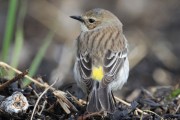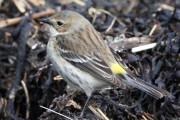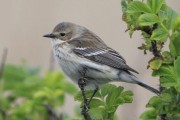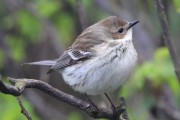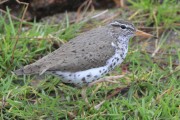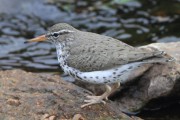Yellow-rumped Warbler at Haroldswick, Unst May 7th/8th 2014
Posted by Brydon Thomason on Friday 16th May 2014 | Birding in Shetland
Unst resident birder and team member Robbie Brookes shares his exciting discovery of the Unst Yellow-rumped Warbler, which remarkably was proven to be the Orkney bird, found just 24 hours before. His luck didn’t stop there though – just hours later he scored with a Subalpine Warbler while trying to relocate the Yellow-rumped – And as if this was not enough, within a week on the 15th he added Spotted Sandpiper to his spring rarity finding spree! Nice work, keep it up Robbie…
Around 9.30am on the 7th May 2014, I decided to take a drive up the north of the island to look for migrants as we’d been having quite a spell of south easterlies. My first stop was going to be Haroldswick Pools which had been particularly good for some of the commoner migrants over the preceding weeks (Blackcaps, Chiffchaffs, Brambling etc and also Wryneck and a Hawfinch). Unfortunately as I drove down the hill I could see a small vehicle parked there, so I decided to go further north and check Skaw, Lamba Ness and Norwick first.
Returning back to the pools some time after 11am, I pulled up and within a minute or so, I noticed a small bird at the far end of the Rosa which was facing me with its head slightly turned. It seemed to have quite a pale breast, slightly streaked with a contrasting dark head. I had a feeling it wasn’t anything I’d come across before; so, doing what I always do, I grabbed the camera and managed to fire off a few frames just in time before it dropped down in to the Rosa bushes. Checking the pictures on the back of the camera, I knew was something pretty unusual and had a ‘gut’ feeling it was an American warbler due to its overall ‘structure’. However, my experience of American passerines was limited to just two birds – a Red-eyed Vireo that was at Valyie on Unst in September 2012 and the Cape May Warbler found by Mike Pennington in Baltasound in October 2013.
As I looked through my ‘Collins’ guide and also the ‘Sibley’ app on my iPod, I kept an eye on the bushes for the bird to re-appear; thankfully it did and I got to see its bright yellow rump. Time to ‘phone a friend’ I thought.
The first call was to Brydon Thomason at around lunchtime, who I knew was on the island. Brydon however, was out guiding an Otter Photography itinerary at that time and when we spoke could do little more than whisper as they were watching otters. He suggested I photographed the back of the camera screen with my phone and send him some pictures. This I did, but they just wouldn’t send – probably down to the image sizes and the pretty slow network that we have here. The next call was to Chris Rogers who was also birding around the north of Unst, all I got was his answerphone, so I left a message and hoped he got it. Last but not least, I emailed and texted Mike (Pennington) who I knew would be teaching at the school – maybe he would have time to come down at lunchtime? After what seemed like a long time, Chris pulled up. He was oblivious to what I thought I’d found as he’d not received my call (when he arrived, he took my excitement to be that I’d re-found the Wryneck !) He looked at the pictures and confirmed it was indeed a Yellow-rumped Warbler (plus a few expletives!).
Shortly after, Brydon arrived with his guests and then a while later, several other local birders from Mainland arrived. Most of the time, the bird only showed briefly when it came to the outside of the bushes to feed, before flitting back to cover. By mid-afternoon it hadn’t been seen for a while, so it was suggested to look around the village. I decided to drive up to a nearby croft cottage with a nice overgrown garden. I didn’t find the Y-r Warbler, but I did get a brief view of a Sub-alpine Warbler – too brief to get its race. I phoned Brydon again but we couldn’t relocate it. Thankfully it was re-found later by Brydon and Chris and eventually identified as a ‘western’.
By 5.45pm I had to return home to Baltasound, but a number of people continued to look for the bird, which then turned up back at the Rosa bushes around 7.45pm and was seen by a number of people.
The following morning I was up at 5am to go and see if the bird was still there. By 5.45am, I’d seen the bird and by 6am the news had been put out again by Brydon that it was still present. I then spent most of the morning watching and photographing the bird; on this day however, it was behaving differently. Instead of skulking around, it was now perching on the tops of the bushes, fly catching and even going down on the ground to feed in the open. I checked the bushes again the following morning but it had moved on.
I had seen that there had also been one on North Ronaldsay the day before, but I didn’t think for one minute that this could be the same bird. When I heard later that the pictures of the two sightings had been compared and it was confirmed it was indeed the same bird, it hit home how lucky it was for the bird to be re-found 130 miles away, let alone that it was me that found it.
Robbie Brookes, 15th May Baltasound Unst


